
Taking a trip with Grandpa

Youngster gets a red wagon ride from Grandpa through Uptown Westerville. My Final Photo for June 15, 2013


Youngster gets a red wagon ride from Grandpa through Uptown Westerville. My Final Photo for June 15, 2013

There is little to say about these two youngsters except they are the best of friends, almost inseparable in their affection for each other.
They are children of families where I tangential knowledge of the parents through people I work with and were at an event in the early evening that I attended.
The mother of the girls wanted a photo of them together and seemed slightly pained that I told her to wait until after the event so I could get them outside for what I knew would be much better than the two of them in a meeting room at the library.
The only camera I had with me was the D5000 with the 18-55mm kit lens and a 50mm f1.8 lens that isn’t designed to autofocus with the D5000. That meant I would have to manual focus at f1.8 to get the photo I wanted and the photo her mother didn’t expect.
It is possible to manual focus with the D5000 even with the narrow depth of filed of an f1.8 lens. In the lower left corner is a circular indicator that flashes as you approach optimum focus and glows steady when you are in focus. It works best when you are set to single focus point, especially when your subject is a portrait and you want to focus on the eyes.
All Nikon cameras have this indicator so you can manually focus any lens. It is indispensable when you are shooting with a lens that requires the camera to have a focus drive motor. The 50mm f1.8 and 85mm f1.8 that I carry do not have the autofocus capability on the D5000 or D3100 I use. They do work on the D300 because it has the focus motor built into the camera.
These two lenses are very popular as a second lens purchase. However, make sure they work in autofocus on your camera or get ready to watch the flashing circle.

Earlier today one of my Facebook friends pointed me towards a New York Times story with a remarkable photo of a lone person walking through dust and debris in a canyon of buildings destroyed by the war in Syria.
I always enjoy our online conversations because each of us have strong opinions, don’t always agree, respect each other, and love photography.
Today we agreed that it’s very difficult for a photographer to express pride or contentment having to shoot photos like the one he pointed me to. It’s not an enjoyable task, shooting disasters and deaths.
I spent almost all of my photojournalism career shooting moments that weren’t necessarily very enjoyable. There’s plane crashes and auto wrecks. Funerals for police, firefighters, children, military, the famous and infamous.
The photo at right is one of those moments where journalism overcame emotion and fear in an attempt to communicate to newspaper readers the gravity of burying six children at the same time.
There were only three frames of film from this viewpoint. I’d left my other cameras with telephoto lenses in the car and walked up to the crowd of mourners carrying one camera with a wide-angle lens. I stood quietly at the edge of the crowd gathered tightly against the edge of the tent covering the families and the caskets. I stayed quiet, my camera concealed under my winter coat, until I could see through the space between the heads of several mourners that emotion had reached its zenith.
As the parents hugged and the pastors said the final prayers I reached over the crowd positioned my camera in where I hoped it would be a good angle and fired three frames. No motor drive. This was film days and cameras still had a thumb drive for moments just like this.
As soon as I shot the three frames I returned to my car and left.
I knew I had photos to help tell the anguish of a funeral for six children. Also, I didn’t want to explain my actions to anyone who was offended.
My actions were cold and calculated. I anticipated one of the reactions would be anger at me. Still, the story needed to be told. I am a photographer. I did what was needed to tell the story.
No one chased after me. No one complained. There were no nasty letters from readers.
I did receive congratulations for succeeding with a good photo in such a tough situation.
I thought of this photo when I had my Facebook conversation this morning. Especially after what had happened the night before.
One of my granddaughters visited last night wanting me to give her a bunch of black and white prints from my archive so she could decorate the walls of her room. Among her choices, in addition to the dogs, cats, and skunk photos, were photos of Jerry Rubin, Jane Fonda, Stokely Carmichael, a couple of presidents before Clinton, andassorted spot news photos. Sandwiched in the collection now covering her walls are old news photos showing disasters, insurrection, injury, and recovery.
All are now decoration for a teenager’s room. They are not even the poignant records of events forgotten in time except for the participants, and the photographers who were the observers.
They are decoration, wallpaper in black and white blurred to the grays of history.
At right is My Final Photo for Monday, April 8, 2013.